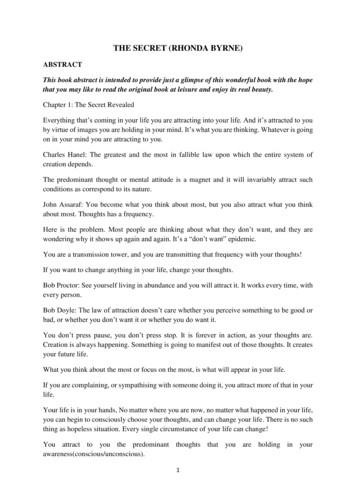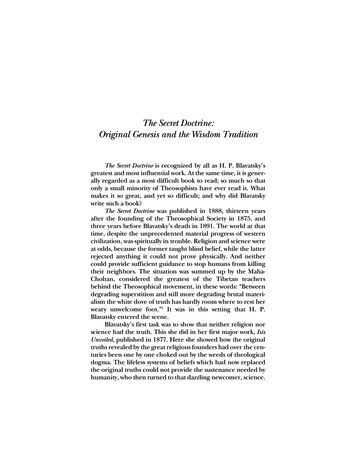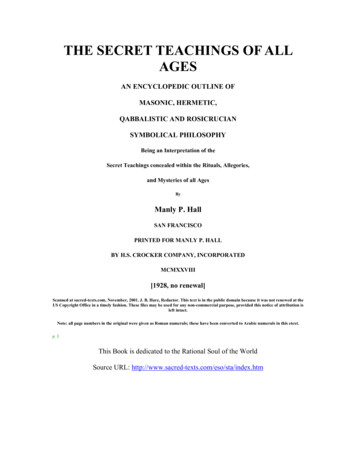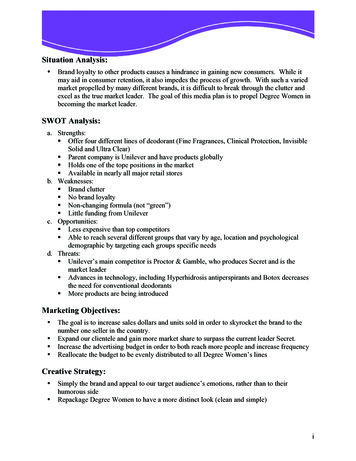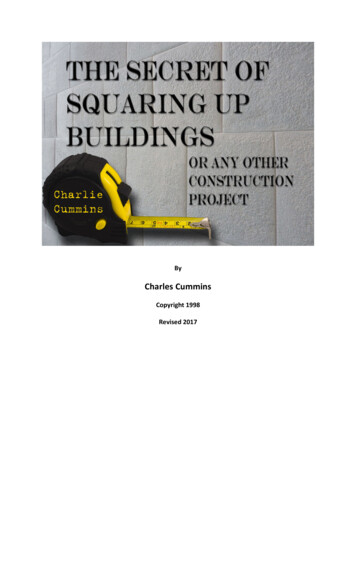
Transcription
ByCharles CumminsCopyright 1998Revised 2017
Table of ContentsForwardHistory Of The CourseAbout The AuthorHow And Why I Learned The Secret Of Squaring UpHow To Figure Your Diagonal On Five Projects which In Turn Will Teach You ToDo Any Project In The FutureEstablishing Your Corners At The Actual Jobsite Perfectly Every TimeConclusion2
ForwardThank you very much for your order. What you are about to learn, in my opinion, simply can notbe beat when it comes to squaring anything for both speed and accuracy. If you ever find orknow of a better, faster, or more perfect way do it please do let me know and I will gladly sendyou a refund and change to your method.3
History Of The CourseThe Secret of Squaring Up and the home study Master Mason Course were created andcopyrighted in 1998. The Secret of Squaring Up was established in order to show others how tosave time and how to perfectly square up any square or rectangular project. The Master MasonCourse was created to provide hands on training and teach employable skills in the masonrytrade so that the course taker could learn to be brick or block layer in the comfort of their ownhome.The Master Mason Course is the realization of Charles L. Cummins dream of sharing his 36 yearsof experience as a bricklayer, contractor, and a school founder to others.4
About The AuthorCharles was born in Sherman, Texas and has dedicated his working career to the masonry trade.Few people could ever love the masonry trade as much as Charles does. He likes to share hisknowledge and pass on his learned skills to anyone else who wants to learn it too.5
How And Why I Learned The Secret Of Squaring UpLet me tell you the story of how I learned to square up projects the way that I do,hopefully you’ll find it both educational and amusing. I have a High School diploma, though Iwas a sophomore twice and then a senior. The teachers liked me but they knew I wasn’t collegebound. Fortunately still let me graduate. I was one of those guys who should have started layingbrick when I was 15 instead of 18. I started laying brick in 1963. Ninety-five percent of my entirebricklaying and contracting career has been on commercial projects, schools, warehouses,shopping centers, power plants, airports, and military bases. Of the ninety-five percent of jobsthat I have done over the years, it has been others, meaning engineers, surveyors and so forth,who had actually established where the corners were to lay. It was that other five percent thatforced me to find a better way.In 1973, I was working in Fairbanks, Alaska for a masonry contractor who had to findhis own corners and square them up. It would take 3 or 4 of us between 3 or 4 hours to get itdone using the Pythagorean “three, four, five” rule, or perhaps the “fifteen, twenty, twenty five”rule to find the proper square corners of the buildings we were working on. After finding whatwe thought were the corners, we would often end up being anywhere from 6 inches to 2 feet ormore off when we went to measure diagonally. I don’t believe anyone could have tried to bemore accurate than we did. What we usually ended up doing was splitting the difference andmoving this line or that line. There was a particular project where the building measured about240 feet, 0 inches by 60 feet, zero inches with all kinds of porch and entry way jogs in it. Well ittook us close to three hours to finally get our corners square and when we did, we realized thecrew who put the footer in was way off. In fact, the block was totally off the footer!The general contractor and owner (who had also done the footer) said, ”Oh, screw it,put the block on the footer and I’ll have my carpenters fix it.” Sound familiar? To this day I stillsometimes wonder just how much that fancy condominium in Fairbanks, Alaska is really out ofsquare. I’ll never know because I don’t intend to go back there and figure it out. Anyway, I am6
sure the carpenters blamed us and the buck passing started, but that’s not the point. The pointis, look at how much all trades had to suffer in lost time because the building was not square.They did not know what I am about to teach you - The Secret Of Squaring Up.Now, I am going to clear the air in case there’s anyone out there that thinks it’s just thebricklayers’ and construction workers who are the dummies. After Fairbanks, I went to Mexicofor 5 months of vacation. I met a lot of great people from all walks of life who were also therefor the winter. One was an Electrical Engineer for Lawrence Radiation out of Berkeley, California.Translated, that means this guy was actually involved in the detonating of atomic bombsoutside of Las Vegas, Nevada! Anyway, I told him about the Fairbanks condominium. Helaughed and said, ”All you have to do is find your Hypotenuse.” I said, ”What?” (Basic math wasall I had passed in High School). The Bomb Man, as we called him, said, “Well, constructionpeople probably call it the diagonal of a square or rectangular shaped object.” I had heard ofdiagonals before. I asked him, “Well, how do you figure it out?” He said it was easy, “You simplysquare the sides, add the numbers, and find the square root.” Although it had been 10 or 11years since high school, I did remembered hearing about square roots, not that it really matterssince I had probably flunked square roots anyway. I told him, “I can multiply the sides and addthem up, but can you show me how to find the square root of that big number?” He said sure.Well, he couldn’t remember, and his wife still talks about all the hours we spent trying to figureit out while in Mexico. He never was able to explain it to me as he had forgotten it himself!When I got back to the U.S., I ran into my brother-in-law. It just so happens that mybrother-in-law, along with several others, was credited for having invented fiber optics. I toldhim my problem and he said, “No problem! I’ll show you how.” To make a long story short, hecouldn’t remember how to do it either! Luckily he still had his old high school math book. Hereviewed it and showed me how to find the square root of that big number on a sheet of paper.I then practiced until I had mastered it. Thank goodness 6 months later I found a pocketcalculator that had the MAGIC f(x) ( or 2 x ) symbol on it. Since then, I have never tried to do iton paper again. Now after hearing this story, is it any wonder that a lot of people in theconstruction industry won’t be able to do it the way that I am going to show you?OK, get a pen, paper, and a calculator that has the magic f(x) ( or 2 x ) symbol on it. If7
you are using an iPhone, turn your calculator app on and turn your phone sideways, you can seeit there as well. I am going to give you five actual building sizes and we are going to work onthem together. Practice these until you understand what you are doing. Then you will be ableto do any project once you have mastered it.8
How To Figure The Hypotenuse Of A Square Or Rectangular BuildingFirst, there is a formula for finding the hypotenuse of a triangle. What it comes downto is that if you know the lengths of two sides of a triangle, you can find the third length byusing this formula. If you cut a square or rectangle in half from one corner to the other, youwill end up with two triangles. Here’s the actual formula:A2 B2 C2A One side of the building.B Another side of the buildingC The unknown distance from one corner of the building to the other diagonal corner of the building.Problem 1The first example is a building 300 feet, 0 inches by 280 feet, 0 inches.The first thing you do is to square the sides. All that little raised 2 in the formula above meansis that the number is multiplied by itself.Side A is 300 feet. 300 x 300 90,000. A2 90,000Side B is 280 feet. 280 x 280 78,400. B2 74,800Add A B 168,400. C2 168,400Now, with 168,400 in your calculator simply punch in for the f square root (or 2 x).You now have 410.36569. Which means your diagonal is 410.36569 (and a long string of trailingnumbers) feet.It’s 410 feet long, but how many inches does the .36569 come out to?With this number on your machine, subtract the 410, which will leave you with .36569* inches.What percent of .36569 is 12 inches?To find this, you simply multiply that number by 12 (inches) and you will get 4.38828 inches.Okay, it’s 4 inches, but what about that fraction of inches left over? If you want to measure to9
the 1/8th of an inch, subtract the 4, which leaves you with .38828 (and a long string of trailingnumbers).Multiply that by 8. This gives you 3.1062 (and a long string of trailing numbers).You can now simply round it up to 3. So now we have 3/8 inches.The answer is 410 feet, 4 and 3/8 inches.Do you understand?We’ll do some more, then you make up more numbers for buildings and you simply practiceuntilyou understand how to find the right answer for any building size that is a square or rectangularshaped building. Here we go.Problem 2A building 60 feet by 30 feet.60 x 60 3,60030 x 30 900Added together and you get 4,500Hit the square root key and you get 67.082039 feet. Subtract the 67, which leaves .082039inches. Multiply that by 12 and you get .984468 inches. Basically, that’s super close to 1 inchand you don’t need to go further.The answer is 67 feet, 1 inch.Problem 3A building is 100 feet even by 150 feet even.100 x 100 10,000150 x 150 22,500Added together 32,500Hit the square root key and you get 180.27756 feet. Subtract 180 and you get .27756 inches.Multiply that by 12 (inches) and you get 3.33076 inches. Subtract the 3 inches and you10
get .33076. Multiply .33076 by 8 (to get the nearest 1/8th inch) and you get 2.64. Round it up to3 and you get 3/8th of an inch.180 feet, 3 & 3/8th inches. This is really close to the ½ inch mark and you could use that aswell.Note: If you want to go to the 1/8th of an inch you multiply that final fraction by 8. If youwant to go to the nearest ¼ of an inch, you would multiply it by 4, and if you wanted to getdown to the 16th of an inch you would multiply it by 16.Problem 4A building is 24 feet by 12 feet.24 x 24 57612x12 144,Add those together 720Hit the square root key and you get 26.832815’. Subtract the26.8328 feet. Subtract 26 feet, and you have .8328% of 12 inches. Multiply that and you get9.99378 inches. .99378 is so close to 10 inches, you don’t need to go any further.The answer is 26 feet, 10 inches.Now the last example will be about as hard as you will ever encounter.Problem 5A building is 88 feet, 8 inches by 100 feet, 8 inches.I always do everything as close to perfect as possible. I even figure concrete and grout by thecubic inch to get exact yardage. I convert the above to inches, and then square it. You could call8 inches 2/3, .67, or .68 but it won’t be perfect. Let’s consider all of the other trades who willshow up after you do and do it perfectly.Here is how to convert feet to inches.11
One foot is 12 inches. 88 feet x 12 inches 1,056 inches. But it was 88 feet PLUS 8 inches, so weadd another 8 inches to that and get 1064 inches. Now we square that: 1064 inches x 1064inches 1,132,096 inches100 feet x 12 inches 1200 inches, plus another 8 inches 1208. We square that and get 1,459,264 inches.Add 1,132,096 1,459,264 2,591,360.The square root of that 1609.7701 inchesDivide by 12 (inches) 134.1475.Subtract 134 feet .1475 inches. Multiply that 12 (inches) to get 1.7701 inches.Subtract 1 inch to get .7701, multiply by 8 (to get down to 1/8th of an inch) to get 6.1608,rounded to 6. You get 6/8th inch, which can be further reduced to ¾. Inch.Your final answer is 134 feet, 1 and ¾ inches.The dotted lines equal the Hypotenuse, or the diagonals.Got it? Keep practicing!12
Establishing Your Corners At The Actual Jobsite Perfectly Every TimeOur project will be the building that you have already practiced which was 100 feet, 0 inches by150 feet, 0 inches. The diagonal was determined to be 180 feet, 3 and 3/8 inches. For thislesson we will assume no one has even given you a straight line or a starting point (normally youwould at least have that). However, you must be given some information on how to establishyour straight line and starting point.Somebody, the engineer, the owner, or the water boy tells you to come in 65 feet, 0inches from the telephone pole that has a nail and red paint on it and to then to come in 105feet, 0 inches from the stake with a red ribbon and a nail in the center. This stake is located inthe center of an alley. This information will get you a straight line. They also tell you to come in45 feet, 0 inches from the curb that has a nail and red paint on it to find your starting point.What you have with the above information looks like:Stake with nail in center13
Let’s do it! When I arrive on the job I have one assistant with me. The straight line andthe starting point have been established. The footer is above ground with no obstacles insidethe building that we are now going to square up. I jump out of my corvette with a hammer, 5 or6 concrete nails about 1 inch or 1½ inch long, my 300-foot tape measure, and a pencil. I tell myassistant to go get us some coffee and donuts.I walk to the starting point (lower left corner) and hook my tape measure to thestarting nail. Now, I start walking up the straight line (upper left corner). When I get to 150 feet,0 inches on my tape, and I simply mark an X exactly on my straight line at exactly 150 feet, 0inches on my tape. I now drive a concrete nail in this corner, which is the upper left corner ofthe building. It looks like this:14
The building is 100 feet, 0 inches by 150 feet, 0 inchesYour diagonal is 180 feet, 3 and 3/8 inchesI now leave my tape hooked to the starting point nail (lower left corner) and I startwalking to the upper right corner (dotted line).I am watching my tape as I approach the upper right corner, and I am looking for 180feet, 3 & 3/8th inches (the diagonal of this job). When I get to the upper right corner with 180feet, 3 & 3/8th inches on my tape. I ask my assistant (who has just returned with the coffee anddonuts) to stand halfway at 90 feet 1 ¾ inches on my tape and hold up the slack in the tape so Ican get a TRUE reading. I tell my assistant 90 feet 1¾ inches because I want him to understand15
how important and serious I am about what we are doing. I also tell my assistant not to worryabout the coffee getting cold because it came from Dunkin Donuts and everybody knows howhot their coffee is. We are almost finished squaring up this 150’- 0” x 100’- 0” building.While standing at the upper right corner, I now swing the tape measure in about a 2 or3-foot arc, marking it on the footer/slab at exactly 180 feet, 3 and 3/8th inches on the footer.Remember this first arc is located at the upper right corner.I now walk back to the starting point nail, unhook my tape and walk to the upper leftcorner of my straight line. When I get there I simply hook my tape to the nail located on theupper left corner of this project. I now walk to the lower right corner of the project. When I getthere, my assistant once again holds up the slack on the tape while standing at 90 feet 1¾inches. Be sure to stress importance to your assistant! We must imbed in our assistant that weare serious and want to be perfect. I now draw another arch on the footer with my pencil atexactly 180 feet, 3 and 3/8th inches on the lower right corner.I ask my assistant to go get the coffee and donuts and meet me A.S.A.P. at the cornerwhere I had just drawn my last arch on the footer, which is the lower right corner of this project.My tape is still hooked to the upper left corner nail, so I leave it there as I head for theupper right corner arc. When I get there, I simply pull my tape and when 100 feet, 0 inchesexactly touches the arc I drew earlier, I mark that spot on the arch exactly at 100 feet, 0 inches.Remember that the building is 150 feet, 0 inches by 100 feet, 0 inches. I now drive a nail in thefooter at the exact spot my 100 feet, 0 inches touched the arch. I now have established theupper right corner.16
All corners are now established except the lower right corner.Got to hurry, coffee is just right. I now unhook my tape from the upper left corner, and Iwalk to the lower left corner (starting point) and I hook my tape to the starting point nail (lowerleft). I now walk to the corner where the coffee and donuts are (lower right). When I get there Isimply mark 100 feet, 0 inches on the arch as I did on the upper right corner. Remember; markexactly the spot where the 100 feet, 0 inches mark is on the tape touches the arch. Nail rnerArchNAIL ITStartingPointMy friend, you can now sit down with your assistant and enjoy your coffee. You havejust squared up this 150 foot by 100 foot building in less than 30 minutes and it is as perfect asperfect can be. There is simply no faster or efficient way to square a building and be perfect.Here is a diagram of what I just showed you. Study it; practice it, until you learn it. Then tellsomeone you like how to do it. Especially, tell your people.17
You are now square. You now can see how much easier squaring anything can be onceyou know the diagonal. Now you won’t have to waste time by squaring any other way known tomankind. When you finish, you won’t have to check to see if your diagonals are the same, and ifthey are not, split the difference and move this corner and that corner until you have the rightnumber? (Forget it) Know the right number before you start the job.18
ConclusionThis concludes The Secret of Squaring Up. Once again I would like to thank you for purchasingthis squaring up method. We also have a home study video brick-laying course with lessonplans. We guarantee that along with this course, once you successfully complete it you will beable to go to work as a brick or block layer or we will refund all of your money. Now that’s aguarantee!For more information please visit: www.BrickLayingSchool.comThank you and have a great day,Charles L. CumminsP.S. Tell a friend about The Secret of Squaring Up. Let’s all do our part to help square up thegreat construction industry.19
bricklayers’ and construction workers who are the dummies. After Fairbanks, I went to Mexico for 5 months of vacation. I met a lot of great people from all walks of life who were also there for the winter. One was an Electrical Eng

